Services on Demand
Journal
Article
Indicators
-
 Cited by SciELO
Cited by SciELO
Related links
-
 Similars in
SciELO
Similars in
SciELO  uBio
uBio
Share
Revista Peruana de Biología
On-line version ISSN 1727-9933
Rev. peru biol. vol.18 no.2 Lima Aug. 2011
TRABAJOS ORIGINALES
Vegetative adaptability of the Peruvian palm Astrocaryum perangustatum to deforestation
Adaptabilidad vegetativa a la deforestación de la palma peruana Astrocaryum perangustatum
Héctor Aponte1 ; Francis Kahn2 and Betty Millán1
1 Museo de Historia Natural. Universidad Nacional Mayor de San Marcos (UNMSM). Av. Arenales 1256, Jesús María, Lima, Perú.
Email Betty Millán: bmillans@gmail.com
2 Institut de Recherche pour le Développement (IRD, UMR-DIADE/ DYNADIV), Casilla 18-1209, Lima, Perú.
Email Francis Kahn: francis.kahn@ird.fr
Abstract
Variation in vegetative morphology of the palm Astrocaryum perangustatum as a response to deforestation was evaluated from a sample of 60 individuals (30 in forest and 30 in pasture) located in the Pozuzo region of Pasco, Peru. Several parameters are significantly different between palms growing in the forest understory and those growing in pasture. These include: number of leaves in the crown, length of the stem, of the leaves, length and width of proximal pinnae, width of medial pinnae, size of spines in adult palms, and number and length of leaves in seedlings. Variation in vegetative morphology of Astrocaryum perangustatum between forest and pasture is discussed in relation to environmental conditions. Morphological variability in the Pozuzo region is compared with that obtained from herbarium vouchers collected throughout the distribution area of the species.
Keywords: Arecaceae, adaptability, palm leaves, deforestation.
Resumen
Se evalúan los cambios de morfología de los órganos vegetativos de la palmera Astrocaryum perangustatum en relación a la deforestación al comparar una muestra de 60 palmeras (30 en áreas de bosque y 30 en pastizales) de la región de Pozuzo (Pasco, Perú). Múltiples parámetros morfológicos (número de hojas, largo del tallo y de las hojas, largo y ancho de las pinnas proximales, ancho de las pinnas mediales, tamaño de los aguijones en palmeras adultas, número y tamaño de las hojas de las plántulas) se revelan significativamente diferentes entre las palmeras que crecen en el bosque y aquellas que crecen en los pastizales. Se discute la variabilidad en la morfología de las partes vegetativas en relación a las condiciones del entorno. Se compara la variabilidad morfológica encontrada en la región de Pozuzo con la obtenida de muestras de herbario recolectadas en toda el área de distribución de la especie.
Palabras clave: Arecaceae, adaptabilidad, hojas de palmera, deforestación.
Introduction
Palm communities play a major role in structure and dynamics of tropical forest ecosystems (Corner 1966, Uhl & Dransfield 1986, Kahn & Granville 1992; Vormisto et al. 2004; Balslev et al. 2011). Palms are also very important in daily life of forest inhabitants. Many species of palms are economically important (Padoch 1988, Holm Jensen & Balslev 1995, Kahn & Moussa 1999). They are used for many purposes, such as food, building material, fiber, salt extraction, ornaments, medicines, and genetic resources (Borgtoft Pedersen & Balslev 1990, Borgtoft Pedersen 1994, Albán et al. 2008, Balslev et al. 2008). Human settlement in the Amazon have consequences as deforestation and habitat fragmentation, produce changes in light, humidity and temperature, water drainage, and animal communities. All these factors influence palm communities, altering species composition, density, phenology, dispersion patterns, recruitment and mortality (Svenning 1998, Scariot 1999, Souza et al. 2000, Galletti et al. 2006, Rodriguez et al. 2007, Montúfar et al. 2011). Small understory palms usually disappear with the destruction of the forest (Johnson 1996). However, several species are frequently present in open areas such as pasture, and seem to tolerate deforestation very well (Borgtoft Pedersen & Balslev 1990). This is the case with most species of the genus Astrocaryum section Huicungo (Kahn 2008). Other palm species may become more abundant, dominant or invasive in open areas as a response to light radiation and low competition (De Steven 1986, Sist and Puig 1987, Scariot et al 1989, Anderson et al. 1991, Mitja & Farraz 2001).
Few studies have assessed the effects of deforestation and subsequent pasture creation on the vegetative morphology of palms, however. The present work analyzes the effect of such drastic ecological change on vegetative morphology in Astrocaryum perangustatum. This species is frequently found in forest understory as well as in pastures in Pozuzo valley, a rich rural region in central Peru. The landscape has been transformed drastically since 1859 when first immigrants settled, most of them having arrived from Austria and Germany and dedicating their effort to cattle breeding. At present, this region is a mosaic of pasture, cultivated areas and patches of primary and old secondary forests (Fig. 1). Apart the botanical description (Kahn & Millán 1992) and some data in schedula from vouchers collected since and deposited at USM herbarium, there were no studies available on morphological variability of the species.
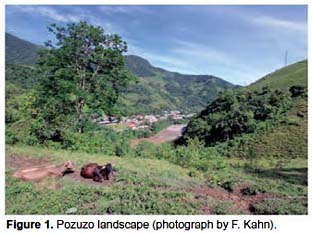
Vegetative morphology of Astrocaryum perangustatum was compared between two contrasting environments: (i) the forest understory, where it grows in a gradient of light that decreases from the canopy to the ground and in constant wet conditions, and (ii) pasture, where it grows under full sunlight in drier conditions and is periodically affected by cattle grazing and burning. This study considered adult palms and seedlings only, because no juvenile palms were found in pasture.
The morphological response of the palm to deforestation gives data on its adaptability as a response to ecological change. It also provides new data on the morphological variability of this species.
Material and methods
Palm studied.–
Astrocaryum perangustatum F. Kahn & B. Millan is a large-leaved, monoecious palm with short stem, 0.5–5(10) m long; sheath of dead leaves are persistent on the stem, at least in its upper part under the crown (Fig. 2). Leaves are regularly pinnate and disposed in one plane. Inflorescences and infructescences are erect and emerge from between the leaf bases. Fruits have the shape of an inverted cone with a remarkably long tapering base. Seedlings have entire, bifid leaves (Fig. 3).
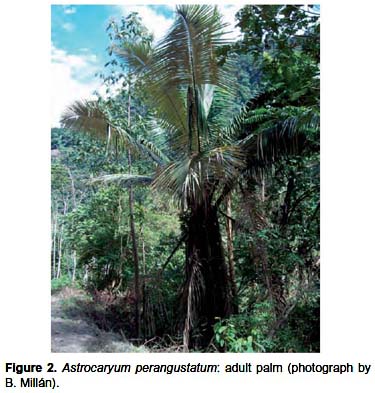
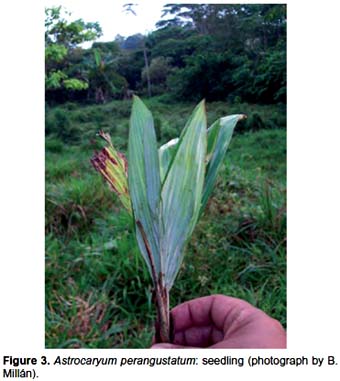
Astrocaryum perangustatum is endemic to Perú (Millán 2006). Its distribution area includes the Pozuzo, Palcazú, Pichis, Perené and Ene valleys (Kahn 2008); it reaches the Pachitea valley northeastwards, and extends to the Apurimac valley in Cusco (La Convención) southwards (Fig. 4). It is locally known as "chonta", "huicungo" or "masanke" (Amuesha).
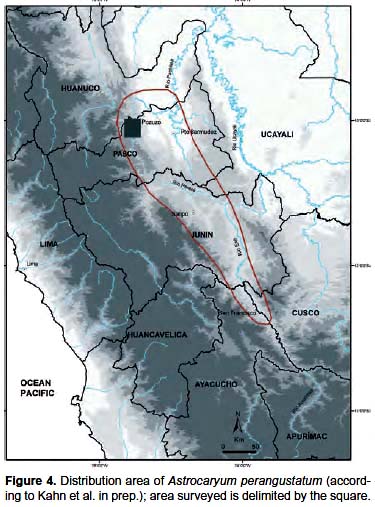
Survey area.– Our study area is located in Pozuzo region, Oxapampa province, Pasco, Peru. Altitude ranged from 800 m to 1200 m. The average mean temperature is 22.6 °C (17.9 °C in highlands) with peaks (28.9 °C) in September and October (CAAL 2009, Cámara de Comercio de Pozuzo 2006). Annual rainfall is 2300 mm. The rainy season extends from November to April with peaks in January and February, and the dry season from May to October with peaks in July and August (Mena 2010). The study was conducted during the dry season between August and November 2009.
In this region, relicts of primary and old secondary forests, the areas of which range from 1 to 24 Ha, are usually found on slopes where they are less frequently deforested. The flora is characterized by Clusiaceae (e.g. Rhedia gardneriana), Euphorbiaceae (e.g. Mabea speciosa), Araceae, Moraceae and Piperaceae. Pastures extend from 2 to 25 Ha; they have been maintained for more than 20 years since deforestation, two of them were deforested around 50 years ago, and one about 150 years ago. Melastomataceae (Tibouchina longifolia, Miconia spp.) and Cyperaceae (Cyperus and Rinchospora) are found in abundance in those open areas. Astrocaryum perangustatum adult palms are found in lower density in pasture, and flowering and fruiting individuals are more frequent than in the neighboring forest. Juveniles are absent in pasture, because they are regularly eliminated by farmers, burned, or eaten by cattle. Seedlings are mainly found close to adult palms (Aponte, unpubl. data).
Morphological parameters.- Palm height was measured with a telescopic pole (to 7 m long) and size of stem, leaves, pinnae and spines with a tape-measure (to 3 m long). For adult palms, total height, stem length and number of leaves in the crown were considered for characterizing the port of the palm. The oldest green leaf in the crown was sampled for each of the selected palms; mean values were calculated for the total length, sheath and petiole length, rachis length, and the number of pinnae on one side of the rachis; average mean values were calculated from samples of 3-6 pinnae taken in each of the medial, proximal and distal parts of the rachis, and from 3-4 largest spines on the sheath of each leaf. For each seedling we measured the length of the largest leaf (petiole and blade).
Sample design.- A total of 60 adult palms, 30 individuals in forest and 30 in pasture, were selected distant from each other by at least 40 m and independently of their size. Our sample also included 46 and 57 seedlings located in forest and pasture respectively.
Statistical analysis.- Significant differences at p<0.05 and p<0.01 were determined using ANOVA test on the software PAST 1.89 (Hammer et al. 2001).
Results
We detected significant variations in morphological traits of Astrocaryum perangustatum from forest to pasture (Table 1). Adult palms present a taller stem in pasture (4.19 vs 2.59 m), and more leaves in the crown (9.96 vs 6.63). The leaf is shorter (530.5 vs 708.0 cm) with both proximal part and rachis shorter (sheath and petiole, 85.7 vs 106.0; rachis 444.8 vs 607.5 cm); proximal pinnae are shorter and wider, medial pinnae are wider. Remaining data on pinnae are not significantly different. The longest spines on leaf sheath are shorter than in forest understory. The two largest leaves (8.9 and 9.4 m long, with 120 and 156 pinnae per side, respectively) are from the two tallest palms found in forest (stem length 5.6 and 6.8 m, respectively). Seedlings have a lower number of leaves (2.05 vs 2.95) and the leaves (blade and petiole) are shorter in pasture than in the forest understory (17.35 vs 27.08 cm and 10.12 vs 22.39 cm, respectively).
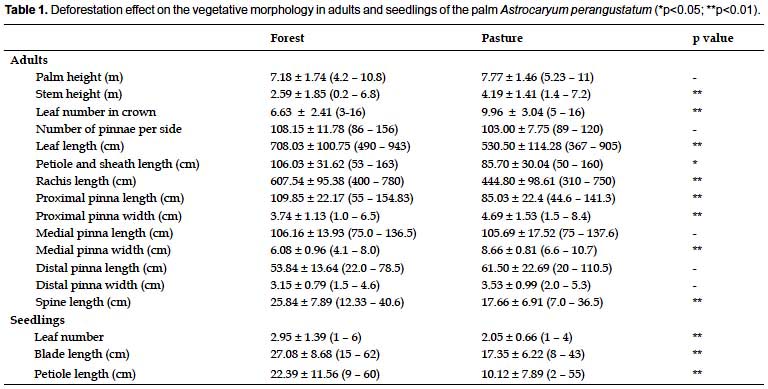
Discussion
Palms in pastures are exposed to full sunlight. Morphological features suggest that adult individuals are more productive in these conditions than they are in forest (longer stem, higher number of leaves in the crown). Low light intensity in forest understory may result in lower productivity for this species. However, data on leaf productivity in Astrocaryum perangustatum are not yet available. Some data were provided for two other species of the genus, Astrocaryum sciophilum and A. paramaca, which grow in forest understory in the Guianas; leaf productivity is very low: 1.1 leaves per year for the former, 1.2-1.3 for the latter (Van der Steege 1983, Sist 1989). Leaves of Astrocaryum perangustatum found in forest have a longer base (sheath and petiole) and a longer rachis than those of individuals found in pasture. This is likely a response to the decreasing gradient of light intensity in the forest understory; the palm has to carry the blade in the highest position to receive more light. The seedling response to low light intensity and humidity in forest understory is a larger size of the entire bifid leaf compared to those seedlings in pasture.
Descriptions of new palm species are most often made from one or a few specimens. To correctly identify taxa in the field, data on the morphological variability within a population and between populations is necessary as is data on how traits vary as a function of environmental change. For example, the type specimen of Astrocaryum perangustatum was collected in an open area, and described as the species having the widest medial pinnae in the subgenus Monogynanthus. While this is correct, the present study shows that most individuals of this species will be frequently found with narrower pinnae when they grow in forest.
Morphological variability of Astrocaryum perangustatum in Pozuzo is high compared with the data in schedula from 13 palms (the vouchers deposited at USM) collected throughout the distribution area of the species (Table 2). Two factors likely account for this: (i) the sample analyzed from Pozuzo region is larger (60 palms vs. 13 for the whole distribution area); and (ii) collectors behavior contributes to bias the range of variability by preferentially selecting the lowest individuals, whose fertile parts are more easily accessible; the larger the palm, the more difficult it is to collect it.

Acknowledgments
This work was done under the agreement between UNMSM/ Universidad Nacional Mayor de San Marcos, Peru and IRD/Research Institute for Development (UMR DIADE/DYNADIV), France, and supported by the PALMS project funded by the European Community, 7th Framework Programme, Grant Agreement N°212631. We are indebted to Catherine Sahley and to Fabien Anthelme for their valuable comments on the manuscript and to Percy Müller for his assistance in the field.
Literature cited
Albán J., B. Millán & F. Kahn. 2008.
Situación actual de la investigación etnobotánica sobre palmeras de Perú. Rev. per. Biol. 15, supl.1: 133-142.Anderson A.B., P.H. May PH & M.J. Balick. 1991. The subsidy from nature. Palm forest, peasantry and development on an Amazon frontier. Columbia Univ. press, New York.
Balslev H., C. Grandez, N. Paniagua, A.L. Møller & S. Lykke. 2008. Useful palms (Arecaceae) near Iquitos, Peruvian Amazon. Rev. peru. biol. 15, supl.1: 121- 132.
Balslev H., F. Kahn, B. Millan, J. Svenning, T. Kristiansen, F. Borchsenius, D. Pedersen & W.L. Eiserhardt. 2011. Species Diversity and Growth Forms in Tropical American Palm Communities. The Botanical Review (Junio). doi:10.1007/ s12229-011-9084-x.
Borgtoft Pedersen H. 1994. Mocora palm-fibers: use and management of Astrocaryum standleyanum (Arecaceae) in Ecuador. Econ. Bot. 48: 310–325.
Borgtoft Pedersen H. & H. Balslev. 1990. Ecuadorean Palms for Agroforestry. Aarhus, Aarhus University Press.
CAAL. 2009. POZUZO. Encuentro de Comunidades Alemanas en América Latina. Pozuzo. Perú.
Cámara de Comercio de Pozuzo. 2006. Pozuzo, Colonia austro alemana en la Selva del Perú. Datos Generales. Disponible on line http://www.pozuzo.org/pozuzo.htm.
Revisado el 29 de junio del 2011.Corner E. J. H. 1966. The Natural History of Palms. Weidenfeld and Nicolson, London.
De Steven D. 1986. Comparative demography of a clonal palm (Oenocarpus mapora subsp. mapora) in Panamá. Principes 30: 100-104.
Galletti, M., C.I. Donatti, A.S., Pires, P.R. Guimarães & P. Jordano. 2006. Seed survival and dispersal of an endemic Atlantic forest palm: the combined effects of defaunation and forest fragmentation. Bot. J. Linn. Soc. 151: 141–149.
Hammer, Ø, D. A. T. Harper & P. D. Ryan, 2001. PAST: Paleontological Statistics SOFTWARE Package for Education and Data Analysis. Paleontologia Electronica 4(1):99. http://palaeo-electronica.org/2001_1/past/issue1_01.htm
Holm Jensen, O. & H. Balslev. 1995. Ethnobotany of the fiber palm Astrocaryum chambira (Areacaceae) in Amazonian Ecuador. Econ. Bot. 49: 309–319.
Johnson D.V. 1996. Palms, their conservation and sustained utilization. Status survey and conservation action plan, IUCN/ SSC Palm Specialist Group.
Kahn F. 2008. The genus Astrocaryum.
Rev. Peru. Biol. 15, supl.1: 31-48.Kahn F. & J.-J. de Granville.
1992. Palms in forest ecosystems of Amazonia. Springer Verlag, Berlin.Kahn F. & B. Millán. 1992. Astrocaryum (Palmae) in Amazonia. A preliminary treatment. Bull. Inst. fr. Ét. and. 21 (2): 459–531.
Kahn F. & F. Moussa. 1999. Economic importance of Astrocaryum aculeatum (Palmae) in Central Brazilian Amazonia.
Acta Botánica Venezuelica 22 (1): 237-245.Mena J.L. 2010. Respuestas de los murciélagos a la fragmentación del bosque en Pozuzo, Perú. Rev. peru. biol. 17(3): 277 - 284.
Millán B. 2006. Arecaceae endémicas del Perú. en: León B. et al. (ed.), El Libro Rojo de las Plantas Endémicas del Perú. Rev. Peru. Biol., Número especial 13(2): 706-707.
Mitja D. & I.D.K Farraz.
2001. Establishment of Babassu in pastures in Pará, Brazil. Palms 45: 138-147.Montúfar R., F. Anthelme, J.C. Pintaud & H. Balslev. 2011. Disturbance and Resilience in Tropical American Palm Populations and Communities. The Botanical Review (Junio). doi:10.1007/s12229-011-9085-9. http://www.springerlink.com/content/t432v3r14668j272/.
Padoch C. 1986. Aguaje (Mauritia flexuosa L.f.) in the economy of Iquitos, Peru. Adv.
Econ. Bot. 6: 214-224.Rodríguez A., A. Aguirre, J. Benítez-Malvido & S. Mandujano.
2007. Impact of rain forest fragmentation on the population size of a structurally important palm species: Astrocaryum mexicanum at Los Tuxtlas, Mexico. Biol. Conserv. 138: 198–206.Scariot A.O. 1999. Forest fragmentation effects on palm diversity in central Amazonia.
J. Ecol. 87 (1): 66-76.Scariot A.O., A.T. Olivera & E. Lleras.
1989. Species density, richness and distribution of palms in an eastern Amazonian seasonally flooded forest. Principes 33(4): 172-179.Sist P. 1989. Peuplement et phénologie des palmiers en foret guyanaise. Rev. Ecol. (Terre et Vie) 44: 113-151.
Sist P. & H. Puig. 1987. Régénération dynamique des populations et dissémination dun palmier de Guyane française : Jessenia bataua (Mart.)Burret subsp. oligocarpa (Griseb & H. Wendl.)Balick.
Adansonia 3: 317-336.Souza A.F., F. Martins & D.M. Silva Matos.
2000. Detecting ontogenetic stages of the palm Attalea humilis in fragments of the Brazilian Atlantic forest. Can. J. Bot. 78: 1227–1237.Svenning J.C. 1998. The effect of land-use on the local distribution of palm species in an Andean rain forest fragment in northwestern Ecuador. Biodiversity and Conservation 7:1529-1537.
Uhl N.W. & J. Dransfield. 1987. Genera palmarum; a classification of palms based on the work of H.E. Moore Jr. Bailey Hortorium and International Palm Society, Allen Press, Lawrence, Kansas.
Van der Steege, J.G. 1983. Bladproductie en Bladfytomassa van het Tropisch Regenbos van Suriname. CELOS rapporten 138, Universiteit van Suriname, Paramaribo, 33 p.
Vormisto J., J.-C. Svenning, P. Hall & H. Balslev. 2004. Diversity and dominance in palm (Arecaceae) communities in terra firme forests in the western Amazon basin.
J. Ecol. 92: 577–588.
Presentado: 21/02/2011
Aceptado: 13/07/2011
Publicado online: 25/08/2011













